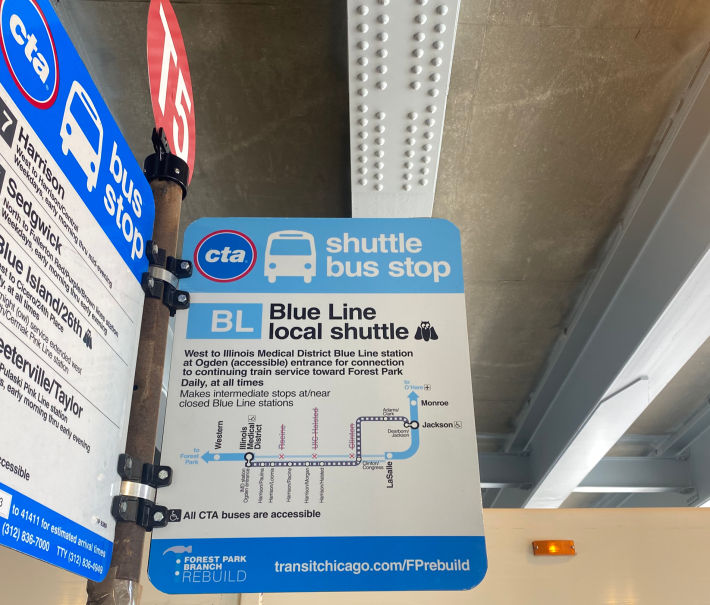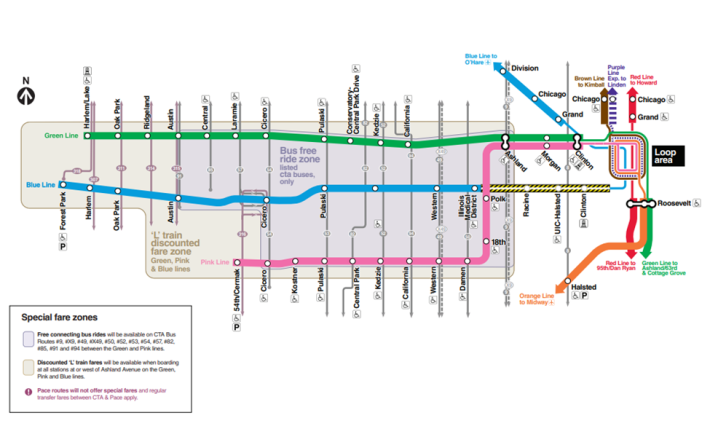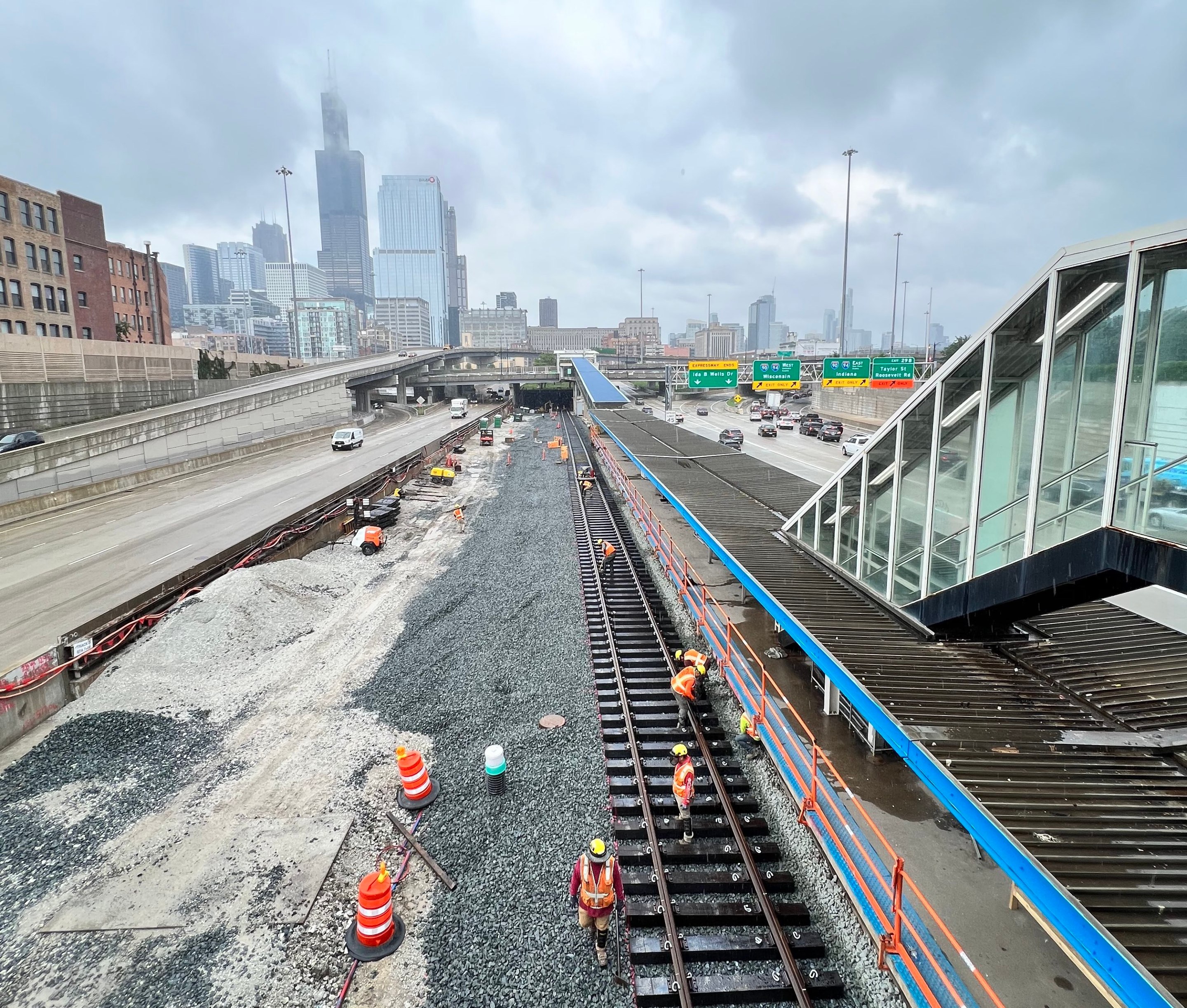
On Sunday, July 23, Phase 1 of the CTA's $268 million project to upgrade the Forest Park Branch of the Blue Line kicked off with the closure of the line between the LaSalle (130 W.) and Illinois Medical District (1900 W.) stations. This would allow workers to completely overhaul 15,000 feet of track, rebuild the Racine station (1200 W.), and update the the traction power system. Phase 1 will hopefully be largely finished by October 7, when this section is slated to reopen.
The initial portion of this phase, dubbed Part A, includes the rebuild of the stretch between the LaSalle and UIC-Halsted (800 W.) stations. It was scheduled to take place between July 23 and late August.
To soften the blow of the line closure for affected Blue Line riders, the CTA is offering free and reduced-price rides on relevant rail and bus lines. During Part A, they've also been running free 24/7 Blue Line Local shuttle buses stopping at all the Blue Line stations between IMD and Jackson (300 S., located on Dearborn Avenue, 30 W.) And during rush hours they've been operating a Blue Line Express shuttle between IMD and Jackson.

The Part B plan
Yesterday, August 15, the transit agency announced that Part A of the Forest Park Blue Line Branch Rebuild is proceeding on time and on budget, and it should wrap up this weekend. And they gave customers a heads-up that there will be service changes when Part B – track and station work between the IMD and UIC/Halsted stops – begins on Monday, August 21.
Starting at 10 a.m. on Sunday, August 20, Blue Line trains will start serving the Clinton (530 W.) and UIC-Halsted stations via the new tracks. So the train route will operate between the O'Hare and UIC-Halsted stops, as well as between the Forest Park and IMD stations. But, obviously, there will be no 'L' service on the roughly one mile between UIC-Halsted and IMD. And the under-construction Racine stop will remain closed. Part B is scheduled to end in October.
The free and reduced-price CTA rail and bus rides will continue during Part B. Check out this article for details on how this program works.

But yesterday the CTA announced that Pace Suburban Bus is also pitching in. Free rides will also be offered on some north-south fixed route Pace buses in the project area. Passengers who get on Pace’s #307, #311, #315, and #318 routes between the Harlem/Lake branch of the Green Line and the Forest Park Branch on the Blue Line won't have to pay a fare.
On Monday there will no longer be rush hour Blue Line Express shuttle buses. But the free 24/7 Blue Line Local shuttles will still be a thing until October.

Transit advocates respond
Streetsblog reached out to local transit advocacy organization for their POVs on this latest news. The Active Transportation Alliance, which has previously praised the Forest Park branch rehab plan, declined to comment on the new CTA statement. This morning the grassroots group Commuters Take Action (CTAction) also had positive things to say about the project, but also said they want more transparency about how the associated schedule changes are affecting commuters.
"We are excited by the progress on the Forest Park Rebuild project," the CTAction said in a statement. "We commend the CTA for being able to resume service to the UIC-Halstead station just in time for fall semester to start at UIC, and we're looking forward to full completion of the first phase of the project to give riders more reliable service."
But the advocates said they are disappointed to continue seeing "little information" on project impact to riders on the still-open stretches of the Blue Line. "There was sparse communication about Blue Line service being reduced between LaSalle and O'Hare in Part A, and as of [Wednesday, August 16] there is no information on how often Blue Line service will run between UIC and O'Hare after [Sunday, August 20, when Blue Line trains start traveling to the Clinton and UIC-Halsted stops again.]
They noted that during Part A, the CTA cut Blue Line service by 14 percent, according to data from the CTA's General Transit Feed Specification public data website. "We're unsure whether the service reduction will continue in Part B. Given the overcrowding in rush hour with only 7.5 minute intervals at best [before the Forest Park rehab began], more frequent trains would ease the pain for thousands of riders. Since July 23 [when Part A started], rush hour intervals of 10 to 15 minutes have been all too common."
On the bright side, CTAction said "Re-opening of the turn-around track at UIC-Halsted should allow CTA to run trains more frequently." They'd like to see trains every six minutes at the very least, the scheduled interval before the Forest Park Branch project. "Pre-COVID, Blue Line trains would run every three minutes during rush hour."
The advocacy group urged the CTA to better inform riders of scheduled service changes. "It's embarrassing that station schedules and [the schedules on the CTA's "Blue Line 'L' webpage] have no mention of service changes. If a rider needs to use the replacement shuttle bus, it's near impossible to plan out the travel time needed – once again the CTA has shared very little in terms of shuttle travel times and frequency."

CTAction said they would like there to be pre-recorded service change announcements on the 'L', instead of relying on train operators to make these announcements themselves. "Digital signage on trains and at stations should have also been updated."
This afternoon the advocacy group got back in touch to express pessimism about whether the turnaround track at UIC-Halsted, mentioned their earlier statement, would actually reopen this Sunday. "From our observations, it appears that the UIC/Morgan turnaround track will likely not be finished by July 20. If that's the case, we are worried about the CTA being able to reliably dispatch trains all the way to UIC with the nearest crossover being just east of the LaSalle station. We are hoping that the CTA has a solid plan for operations and would be interested to hear more details about it."

Did you appreciate this post? Please consider making a tax-deductible donation.





